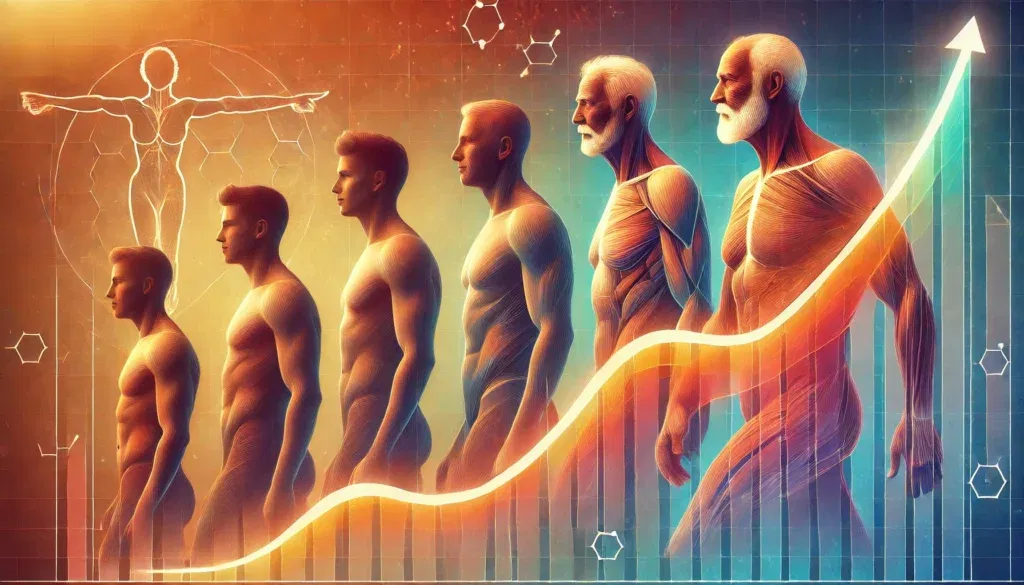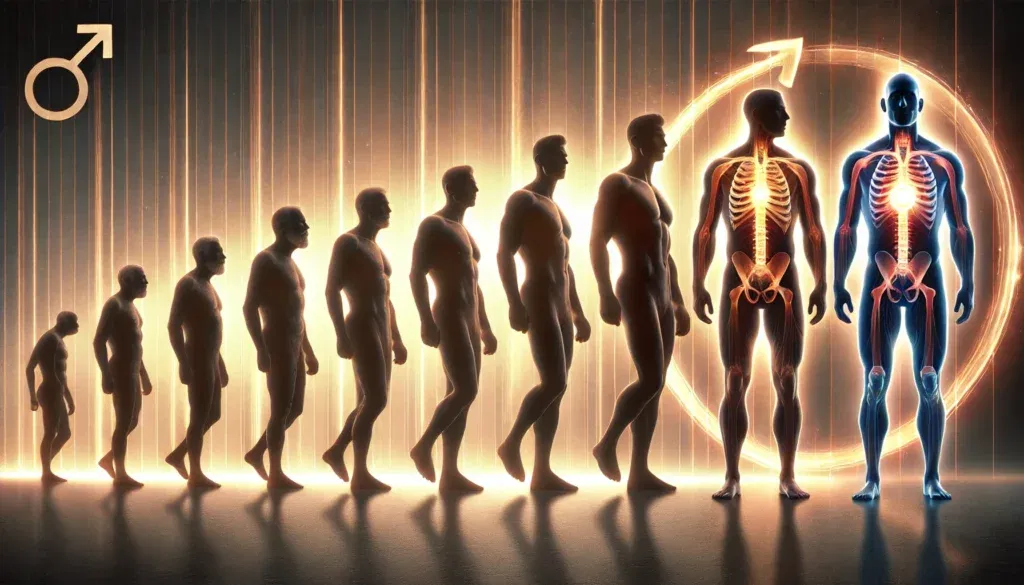Understanding Testosterone and Its Role in Male Health
Testosterone is a vital hormone responsible for numerous physiological functions in the male body. It plays a critical role in muscle mass development, bone density maintenance, red blood cell production, fat distribution, and sexual function. Beyond its physical impact, testosterone also significantly influences mood, cognitive function, and overall well-being. Understanding the importance of testosterone levels throughout a man’s life is essential for maintaining health, preventing deficiencies, and ensuring optimal performance in daily activities.
You may also like: How to Get Your Testosterone Levels Checked: Best At-Home and Lab Testing Options
Testosterone levels fluctuate naturally over a man’s lifespan, peaking during late adolescence and early adulthood before gradually declining with age. While some decrease is expected and normal, significant drops in testosterone levels can lead to undesirable health effects. These may include fatigue, decreased libido, loss of muscle mass, and even mood disorders such as depression. Recognizing the normal range of testosterone levels by age and understanding when deviations warrant medical attention is crucial for proactive health management.
Hormone health is a topic of growing concern, particularly as research continues to unveil the long-term effects of testosterone deficiencies and imbalances. While testosterone replacement therapy (TRT) has become an option for men with significantly low levels, lifestyle interventions such as diet, exercise, and stress management also play a role in maintaining healthy testosterone production. This article explores testosterone levels by age, discusses normal ranges, and identifies when intervention may be necessary to maintain optimal health.

Testosterone Levels by Age Chart and Normal Ranges
The amount of testosterone present in the bloodstream is typically measured in nanograms per deciliter (ng/dL). Several factors, including genetics, lifestyle, and overall health, influence individual testosterone levels. Below is a general guideline of testosterone levels across different ages based on medical research and clinical data.
- Infancy to Childhood (0-10 years): <10-30 ng/dL
- Adolescence (11-17 years): 100-1,200 ng/dL
- Early Adulthood (18-25 years): 300-1,000 ng/dL (peak levels)
- Adulthood (26-40 years): 300-900 ng/dL
- Middle Age (41-55 years): 250-850 ng/dL
- Older Adults (56-65 years): 200-700 ng/dL
- Senior Years (65+ years): 150-600 ng/dL
While these figures serve as general references, testosterone levels can vary widely among individuals. It is important to consider symptoms, overall health, and lifestyle factors when assessing whether testosterone levels are within a healthy range.
When Does Testosterone Peak?
Testosterone levels reach their highest point during late adolescence and early adulthood, typically between the ages of 18 and 25. This peak corresponds with the period of rapid growth and physical development in young men. During this phase, testosterone plays a crucial role in increasing muscle mass, strengthening bones, and enhancing reproductive functions.
Testosterone levels begin to decline gradually after the age of 30 at a rate of approximately 1% per year. This natural decline is often imperceptible at first, but over time, it can contribute to noticeable changes in energy levels, strength, and overall vitality. While some men maintain optimal testosterone levels well into their later years, others may experience a more significant drop, leading to symptoms associated with low testosterone.
What is Considered Low Testosterone?
Low testosterone, also referred to as hypogonadism, is generally defined as total testosterone levels falling below 300 ng/dL. However, diagnosing low testosterone is not solely based on lab values; symptoms play a crucial role in determining whether treatment is necessary. Common signs of low testosterone include:
- Fatigue and reduced energy levels
- Decreased libido and sexual dysfunction
- Loss of muscle mass and increased body fat
- Mood swings, irritability, and depression
- Difficulty concentrating and cognitive decline
- Reduced bone density and increased risk of osteoporosis
It is important to recognize that testosterone levels fluctuate throughout the day, often peaking in the morning and declining in the evening. A single low reading may not necessarily indicate a long-term deficiency. If symptoms are present, multiple tests over different days are recommended to obtain an accurate assessment.
What Should My Testosterone Level Be at 40?
By the age of 40, testosterone levels have typically begun to decline from their peak in early adulthood. The average testosterone level for a 40-year-old male falls between 300 and 900 ng/dL. However, levels closer to the lower end of this spectrum may lead to noticeable symptoms, especially if accompanied by other health concerns.
Men in their 40s experiencing symptoms of low testosterone should consider lifestyle modifications such as regular strength training, a nutrient-rich diet, adequate sleep, and stress management. If symptoms persist, medical consultation is recommended to assess whether testosterone therapy or other interventions are necessary.
Is 617 Testosterone Good?
A testosterone level of 617 ng/dL is within the normal range for adult males. This level is generally considered healthy, as it falls well within the typical range of 300-900 ng/dL. While individual needs vary, most men with testosterone levels in this range do not experience symptoms of deficiency. However, factors such as free testosterone levels and overall health status should also be considered in evaluating hormone balance.
Ideal Testosterone Levels on TRT
Testosterone replacement therapy (TRT) is prescribed for men with clinically low testosterone levels who experience significant symptoms. The goal of TRT is to restore testosterone to an optimal range that alleviates symptoms without causing excessive increases that could lead to adverse effects. The ideal testosterone level while on TRT typically falls between 500 and 1,000 ng/dL.
TRT should be carefully monitored by a healthcare provider to ensure that testosterone levels remain within a safe range. Over-supplementation can lead to issues such as increased red blood cell count, elevated blood pressure, and potential cardiovascular risks. Routine blood tests and symptom assessments are essential for achieving a balance that supports overall well-being.
When to Be Concerned About Low Testosterone
While testosterone naturally declines with age, significant drops below the normal range can have serious health implications. If levels fall below 300 ng/dL and are accompanied by persistent symptoms, medical evaluation is warranted. In some cases, underlying health conditions such as metabolic disorders, chronic stress, obesity, or sleep apnea may contribute to declining testosterone levels.
Early intervention can help mitigate the effects of low testosterone and improve quality of life. Treatment options range from lifestyle adjustments to medical interventions such as TRT. Men experiencing symptoms should consult with a healthcare professional to determine the most appropriate course of action based on individual needs and health status.

Frequently Asked Questions (FAQ) on Testosterone Levels
1. How do testosterone levels change as men age?
Testosterone levels naturally decline with age, and this is illustrated in a testosterone levels by age chart. Most men experience a gradual decrease of about 1% per year after the age of 30. However, the rate of decline can vary due to genetics, lifestyle, and underlying health conditions. The testosterone levels generation chart suggests that newer generations may have lower levels than previous ones, possibly due to environmental factors and dietary changes. Monitoring your levels through regular blood tests can help track changes over time and determine if intervention is necessary.
2. What is the difference between total testosterone and free testosterone?
Total testosterone includes both bound and free testosterone circulating in the bloodstream, while free testosterone represents the portion that is readily available for the body to use. Free testosterone levels by age tend to decline more significantly than total testosterone, which can impact energy levels, muscle mass, and libido. Age-independent testosterone levels dropping chart studies suggest that free testosterone is a better indicator of hormonal health than total testosterone alone. Men experiencing symptoms of low testosterone should request both total and free testosterone tests for a comprehensive evaluation.
3. At what age does testosterone peak in men?
Testosterone levels are highest during adolescence and early adulthood. The answer to “when does testosterone peak?” is typically between the ages of 18 and 25. After this period, levels start declining gradually. According to testosterone levels by age chart male studies, lifestyle choices such as exercise, diet, and sleep quality can influence how quickly testosterone declines. While this decrease is natural, maintaining a healthy lifestyle can help slow the process and preserve optimal levels.
4. Is a testosterone level of 617 ng/dL good?
A testosterone level of 617 ng/dL is generally considered within the normal range for adult males. However, what is considered ideal varies by age and individual health factors. Is 617 testosterone good? It depends on symptoms and overall well-being—some men with this level may still experience symptoms of low T. Consulting with a healthcare provider for a personalized assessment is the best approach to interpreting testosterone levels.
5. What should a 50-year-old male’s testosterone level be?
For a 50-year-old male, testosterone levels typically range from 200 to 700 ng/dL. The 50-year-old male testosterone level can vary based on lifestyle and health conditions. While a level within this range is considered normal, symptoms of low testosterone, such as fatigue or loss of muscle mass, may indicate the need for further evaluation. Testosterone replacement therapy (TRT) may be an option if levels are significantly low and symptoms are present.
6. How do testosterone levels fluctuate during the day?
Testosterone levels during the day graph male studies show that levels are highest in the morning and gradually decline throughout the day. This diurnal variation means that blood tests should ideally be done in the early morning to capture the peak levels. Men experiencing low testosterone symptoms later in the day may need additional assessments. Understanding these natural fluctuations can help optimize treatment strategies, such as timing testosterone replacement therapy.
7. What is considered a low testosterone range?
The definition of low testosterone varies slightly between medical guidelines, but generally, levels below 300 ng/dL are considered low. What is low testosterone range? It depends on factors such as age, free testosterone levels, and individual health conditions. What are low testosterone numbers? Typically, anything below 264 ng/dL, as defined by the American Urological Association, is considered low. However, symptoms play a crucial role in diagnosing low testosterone beyond just lab results.
8. How low is too low for testosterone levels?
A testosterone level below 200 ng/dL is usually considered critically low. How low is low testosterone? It depends on how the body responds—some men experience severe symptoms at 250 ng/dL, while others may feel fine at 400 ng/dL. The testosterone level of 252 men, for example, may lead to symptoms like fatigue, depression, and reduced libido. Addressing lifestyle factors, diet, and hormone therapy can help manage symptoms of low T effectively.
9. Is 2000 testosterone too high?
Yes, a testosterone level of 2000 ng/dL is considered abnormally high and may indicate excessive supplementation or an underlying medical condition. Is 2000 testosterone too high? Yes, in most cases, as it can lead to side effects such as high blood pressure, aggression, and cardiovascular risks. Ideal testosterone levels on TRT typically aim for a range between 500 and 1000 ng/dL to maintain health benefits without excessive risks. Regular monitoring is essential to ensure safe and effective testosterone replacement therapy.
10. What should my testosterone level be at 40?
Testosterone levels at 40 typically range from 300 to 800 ng/dL. What should my testosterone level be at 40? It varies based on genetics, lifestyle, and overall health. Many men begin to notice signs of decline in their 40s, such as reduced energy and muscle mass. Maintaining an active lifestyle and a nutrient-rich diet can help support healthy testosterone levels. If symptoms of low T appear, a doctor can assess whether treatment or lifestyle changes are necessary to optimize hormonal balance.

Conclusion: Taking Control of Testosterone Health
Understanding testosterone levels by age and recognizing when levels fall outside the normal range is crucial for maintaining overall health. While a gradual decline in testosterone is a natural part of aging, significant drops can lead to noticeable health concerns that impact daily life. Monitoring testosterone levels, addressing symptoms early, and making informed lifestyle choices can support long-term well-being and vitality.
For those experiencing symptoms of low testosterone, professional evaluation and appropriate interventions can help restore balance and enhance overall health. Whether through lifestyle changes, nutritional support, or medical treatments, proactive hormone health management empowers men to lead energetic and fulfilling lives well into their later years.
testosterone health, male hormone balance, TRT therapy guide, hormone health for men, signs of low testosterone, aging and testosterone decline, best TRT levels, testosterone deficiency symptoms, peak testosterone age, testosterone and energy levels, male aging and hormones, free testosterone levels explained, optimal TRT dosing, testosterone replacement risks, testosterone testing guide, how to increase testosterone naturally, male vitality and hormones, hormonal changes in men, boosting testosterone naturally, testosterone therapy benefits
Further Reading:
What You Need To Know About Testosterone Levels Across the Lifespan
Typical testosterone levels in males and females
Disclaimer: The information provided in this article is for general informational purposes only. The content does not constitute professional advice of any kind, including but not limited to medical, legal, or financial advice. HisHealthMag and its contributors make no representations or warranties regarding the accuracy, completeness, or reliability of the information presented. Always seek the advice of a qualified professional for any specific concerns or questions you may have. Neither HisHealthMag nor its authors assume any responsibility or liability for any actions taken based on the information provided in this article. The views and opinions expressed are those of the author(s) and do not necessarily reflect the official policy or position of HisHealthMag.





